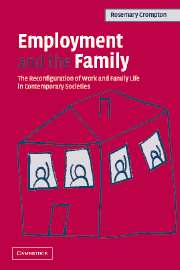Book contents
- Frontmatter
- Contents
- Preface
- 1 Understanding change in employment, family and gender relations
- 2 Caring and working
- 3 Women, men, organisations and careers
- 4 Work–life articulation, working hours and work–life policies
- 5 States, families and work–life articulation
- 6 Households, domestic work, market work and happiness
- 7 Class, family choices and women's employment
- 8 Conclusions
- Appendix A Additional ISSP Family 2002 questions
- Appendix B Joseph Rowntree Foundation (JRF) interviewees cited
- Bibliography
- Index
7 - Class, family choices and women's employment
Published online by Cambridge University Press: 22 September 2009
- Frontmatter
- Contents
- Preface
- 1 Understanding change in employment, family and gender relations
- 2 Caring and working
- 3 Women, men, organisations and careers
- 4 Work–life articulation, working hours and work–life policies
- 5 States, families and work–life articulation
- 6 Households, domestic work, market work and happiness
- 7 Class, family choices and women's employment
- 8 Conclusions
- Appendix A Additional ISSP Family 2002 questions
- Appendix B Joseph Rowntree Foundation (JRF) interviewees cited
- Bibliography
- Index
Summary
In this chapter, we return to some of the issues that have already been discussed in Chapter 2 – in particular, the topic of family ‘choices’ in relation to employment (particularly mothers' employment) and its relationship to class. First, we will explore the role of the family in the reproduction of class inequalities. Many have argued that both ‘class’ and ‘the family’ are no longer relevant concepts in ‘reflexive modern’ societies characterised by increasing individuation and choice, but it will be argued here that despite the considerable changes that have taken place over the last half-century, material and cultural family class practices can still be identified that contribute to the persistence of class inequalities.
Using the ISSP data, we will also critically reexamine Hakim's ‘preference theory’. This has argued that, increasingly, women's employment patterns are an outcome of the choices made by different ‘types’ of women. The ISSP data suggests some grounds for thinking that a minority of women are indeed predisposed to domesticity, but, in all countries, both the attitudes and behaviour of women towards employment would seem to be shaped by a wide range of structural factors rather than the exercise of free ‘choice’ alone. We also examine the factors that shape attitudes to women's employment, whether in a conservative or more ‘liberal’ direction.
In the final section, the ISSP data is used to explore the complex interactions between occupational class, attitudes and mothers' employment.
- Type
- Chapter
- Information
- Employment and the FamilyThe Reconfiguration of Work and Family Life in Contemporary Societies, pp. 163 - 188Publisher: Cambridge University PressPrint publication year: 2006

